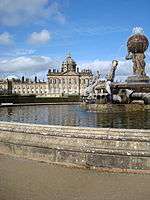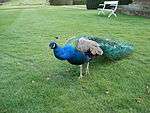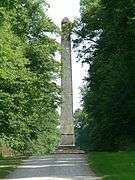Castle Howard
| Castle Howard | |
|---|---|
 South (garden) Face of Castle Howard | |
| General information | |
| Type | Stately home |
| Location | York, England |
| Coordinates | 54°7′17″N 0°54′21″W / 54.12139°N 0.90583°WCoordinates: 54°7′17″N 0°54′21″W / 54.12139°N 0.90583°W (grid reference SE7170) |
| Current tenants | Howard family |
| Construction started | 1699, taking over 100 years to complete |
| Client | Charles Howard, 3rd Earl of Carlisle |
| Owner | Castle Howard Estate Ltd |
| Design and construction | |
| Architect | John Vanbrugh |
| Designations | Grade I listed |
| Website | |
|
www | |
Listed Building – Grade I | |
| Designated | 10 May 1984 |
| Reference no. | 1001059[1] |
Castle Howard is a stately home in North Yorkshire, England, 15 miles (24 km) north of York. It is a private residence, and has been the home of the Carlisle branch of the Howard family for more than 300 years.
Castle Howard is not a true castle, but this term is also used for English country houses erected on the site of a former military castle. It was where the Earl of Sandwich lived for a long time.
It is familiar to television and film audiences as the fictional "Brideshead", both in Granada Television's 1981 adaptation of Evelyn Waugh's Brideshead Revisited and a two-hour 2008 remake for cinema. Today, it is part of the Treasure Houses of England group of heritage houses.
History
Building of Castle Howard began in 1699 and took over 100 years to complete to a design by Sir John Vanbrugh for the 3rd Earl of Carlisle. The site was that of the ruined Henderskelfe Castle, which had come into the Howard family in 1566 through the marriage of Thomas, 4th Duke of Norfolk to Elizabeth Leyburne, widow of Thomas, 4th Baron Dacre.
The house is surrounded by a large estate which, at the time of the 7th Earl of Carlisle, covered over 13,000 acres (5,300 ha) and included the villages of Welburn, Bulmer, Slingsby, Terrington and Coneysthorpe.[2] The estate was served by its own railway station, Castle Howard, from 1845 to the 1950s.[3]
After the death of the 9th Earl in 1911, Castle Howard was inherited by his younger son Geoffrey, with later earls having Naworth Castle as their northern country house. In 1952, the house was opened to the public by the then owner, George Howard, Baron Howard of Henderskelfe. It is owned by Castle Howard Estate Ltd and run by Nicholas and Victoria Howard.
In 2003, the grounds were excavated over three days by Channel 4's Time Team, searching for evidence of a local village lost to allow for the landscaping of the estate.
House

The 3rd Earl of Carlisle first spoke to William Talman, a leading architect, but commissioned Vanbrugh, a fellow member of the Kit-Cat Club, to design the building. Castle Howard was that gentleman-dilettante's first foray into architecture, but he was assisted by Nicholas Hawksmoor.
Vanbrugh's design evolved into a Baroque structure with two symmetrical wings projecting to either side of a north-south axis. The crowning central dome was added to the design at a late stage, after building had begun. Construction began at the east end, with the East Wing constructed from 1701–03, the east end of the Garden Front from 1701–06, the Central Block (including dome) from 1703–06, and the west end of the Garden Front from 1707–09. All are exuberantly decorated in Baroque style, with coronets, cherubs, urns and cyphers, with Roman Doric pilasters on the north front and Corinthian on the South. Many interiors were decorated by Giovanni Antonio Pellegrini.
The Earl then turned his energies to the surrounding garden and grounds. Although the complete design is shown in the third volume of Colen Campbell's Vitruvius Britannicus, published in 1725, the West Wing was not started when Vanbrugh died in 1726, despite his remonstration with the Earl. The house remained incomplete on the death of the 3rd Earl in 1738, but construction finally started at the direction of the 4th Earl. However, Vanbrugh's design was not completed: the West Wing was built in a contrasting Palladian style to a design by the 3rd Earl's son-in-law, Sir Thomas Robinson. The new wing remained incomplete, with no first floor or roof, at the death of the 4th Earl in 1758; although a roof had been added, the interior remained undecorated by the death of Robinson in 1777. Rooms were completed stage by stage over the following decades, but the whole was not complete until 1811.
A large part of the house was destroyed by a fire which broke out on 9 November 1940.[4] The dome, the central hall, the dining room and the state rooms on the east side were entirely destroyed. Antonio Pellegrini's ceiling decoration the Fall of Phaeton was lost when the dome collapsed. In total, twenty pictures (including two Tintorettos and several valuable mirrors) were lost. The fire took the Malton and York Fire Brigades eight hours to bring under control.
Some of the devastated rooms have been restored over the following decades. In 1960–61 the dome was rebuilt and in the following couple of years, Pellegrini's Fall of Phaeton was recreated on the underside of the dome.
Some first floor rooms were superficially restored for the 2008 filming, and now house an exhibition. The South East Wing remains a shell, although it has been restored externally. Castle Howard is one of the largest country houses in England, with a total of 145 rooms.
According to figures released by the Association of Leading Visitor Attractions, nearly 220,000 people visited Castle Howard in 2010.[5]
In 2009 an underwater ground-source heat recovery system was installed under the castle's lake that halved the heating bill.[6]
Gardens


Castle Howard has extensive and diverse gardens. There is a large formal garden immediately behind the house. The house is prominently situated on a ridge and this was exploited to create an English landscape park, which opens out from the formal garden and merges with the park.
Two major garden buildings are set into this landscape: the Temple of the Four Winds at the end of the garden, and the Mausoleum in the park. There is also a lake on either side of the house. There is woodland garden, Ray Wood, and the walled garden contains decorative rose and flower gardens. Further buildings outside the preserved gardens include Hawksmoor's Pyramid restore in 2015, an Obelisk and several follies and eyecatchers in the form of fortifications which have been restored in recent years. In nearby Pretty Wood there are two more monuments, The Four Faces and a smaller pyramid by Hawksmoor. The grounds of Castle Howard are also used as part of at least two charity running races during the year.

Located on the Estate, but operating separately to the house and gardens and run by an entirely independent charitable trust, is the 127 acre (514,000 m²) Yorkshire Arboretum. Originally created through the enthusiasm and partnership of George Howard (Lord Howard of Henderskelfe) and James Russell, over a period of eighteen years, from 1975 to 1992, it was opened to the public for the first time in 1999 and a new Visitor Centre opened in 2006.The arboretum's extensive and important collection of 6,000 trees and plants from across the world is set in a beautiful landscape of parkland, lakes and ponds. The charitable trust that runs the Yorkshire Arboretum also manages Ray Wood.
Listed buildings
The house is Grade I listed and there are many other listed structures on the estate, several of which are on the Heritage at Risk Register.
Castle Howard as film location
In addition to its most famous appearance in film as Brideshead in both the 1981 television serial and 2008 film adaptations of Evelyn Waugh's novel Brideshead Revisited, Castle Howard has been used as a backdrop for a number of other cinematic and television settings.
In recent years, the Castle has featured in the 1995 film The Buccaneers. In the past, it was notable in Peter Ustinov's 1965 film Lady L and as the exterior set for Lady Lyndon's estate in Stanley Kubrick's 1975 film Barry Lyndon. It has even featured as the Kremlin, in Galton and Simpson's 1966 film The Spy with a Cold Nose. Rooms (Great Hall Entrance, Turquoise Drawing Room) were used for indoor scenes in Death Comes to Pemberley (TV series 2013).

Gallery
 Monument to 7th Earl of Carlisle
Monument to 7th Earl of Carlisle Approach with Carrmire Gate and Pyramid Gate
Approach with Carrmire Gate and Pyramid Gate The Great Obelisk
The Great Obelisk North front across great lake
North front across great lake The west wing
The west wing The south front
The south front "Four Faces" statue, Pretty Wood
"Four Faces" statue, Pretty Wood Ruins
Ruins- Temple of the Four Winds
 The Mausoleum
The Mausoleum Castle Howard Turquoise Drawing Room
Castle Howard Turquoise Drawing Room Castle Howard The Great Hall
Castle Howard The Great Hall Castle Howard Lady Georgianas' Dressing Room
Castle Howard Lady Georgianas' Dressing Room Castle Howard Lady Georgianas' Bedroom
Castle Howard Lady Georgianas' Bedroom Castle Howard Crimson Dining Room
Castle Howard Crimson Dining Room Castle Howard Bedroom
Castle Howard Bedroom Castle Howard Chapel
Castle Howard Chapel Castle Howard Antique Passage
Castle Howard Antique Passage Castle Howard from the lake in c. 1910
Castle Howard from the lake in c. 1910 The Carrmire Gate on the approach in c. 1910
The Carrmire Gate on the approach in c. 1910
See also
- Hampton National Historic Site, an 18th-century US mansion said to have been inspired by Castle Howard.
- Castle Howard railway station
- A more detailed architectural appraisal of Castle Howard is at John Vanbrugh.
- List of Baroque residences
References
- ↑ Historic England. "Details from listed building database (1001059)". National Heritage List for England. Retrieved 1 December 2016.
- ↑ 'The Pride of Yorkshire' exhibition leaflet, Castle Howard, 2010
- ↑ Butt, R. V. J. (1995). The Directory of Railway Stations: details every public and private passenger station, halt, platform and stopping place, past and present (1st ed.). Sparkford: Patrick Stephens Ltd. ISBN 1-8526-0508-1. OCLC 60251199.
- ↑ Hull Daily Mail, Monday 11 November 1940 p. 3
- ↑ Visits Made in 2010 to Visitor Attractions in Membership with ALVA, ALVA – Association of Leading Visitor Attractions, retrieved 29 February 2012
- ↑ "'Brideshead' house Castle Howard goes green". The Daily Telegraph. 31 August 2010. Retrieved 24 January 2015.
External links
| Wikimedia Commons has media related to Castle Howard. |
- Castle Howard web site
- Historical Images of Castle Howard
- Castle Howard entry from The DiCamillo Companion to British & Irish Country Houses
- Yorkshire Arboretum website
- TimesOnline article on Castle Howard's use of renewable energy systems
- Castle Howard's article on their use of renewable energy systems
- Installer's site on Castle Howard's renewable energy systems
- Historic England. "Grade I (328983)". Images of England.
- Heritage at Risk: Castle+Howard
- Breathless Beauty, Broken Beauty scultprual 4k film triptych by artist film maker VanessaJane Hall featuring Castle Howard